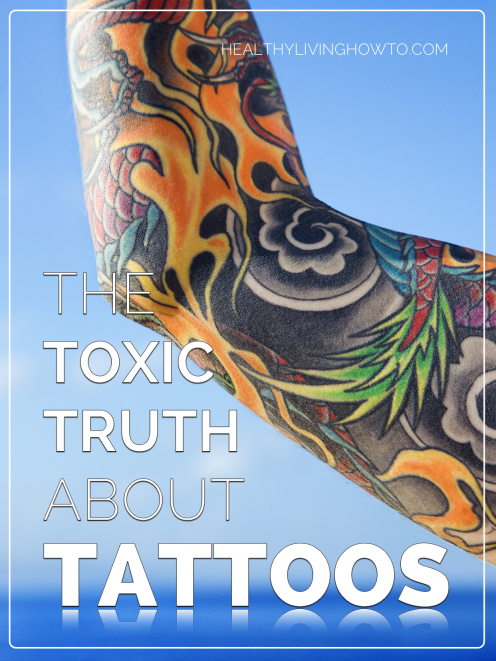I don’t know about you, but I’ve never gotten a tattoo and after reading this study I am glad I avoided them. If you’ve ever gotten a tattoo, or thought about it, chances are high that you weighed the artistic and social aspects of it far more than the health aspects.
In fact, you may not even be aware that there is a health aspect to receiving a tattoo – other than the inherent risks of infection, allergic reaction or disease transmission if equipment is not properly sterilized.
Research is increasingly showing, however, that there might be health risks involved, especially if your tattoo design contains large areas of black ink, as the ink itself may be toxic.
Can Tattoo Ink Lead to Cancer?
It has been said that “tattoo ink is remarkably nonreactive histologically, despite the frequent use of different pigments of unknown purity and identity by tattoo artists.” 1
However, University of Bradford researchers using an atomic force microscope (AFM) that allows them to examine skin with tattoos at the nano-level have found evidence that suggests otherwise. In a preliminary study (the first to use an AFM to examine tattoos), the researchers found that the tattoo process remodels collagen (your body’s main connective tissue). 2
Further, nanoparticles from tattoo ink were found to exist in both the collagenous network of the skin as well as around blood vessels. This suggests that the ink particles are leaving the surface of your skin and traveling elsewhere in your body, where they could potentially enter organs and other tissues.
This is problematic because tattoo inks are largely unregulated and known to contain cancer-causing compounds. The researchers believe the issue could become a significant public health concern given the rise in tattooing in the last decade, noting:
Nanoparticles in Tattoo Ink May be Carcinogenic
Nanoparticles are ultramicroscopic in size, making them able to readily penetrate your skin and travel to underlying blood vessels and your bloodstream. Evidence suggests that some nanoparticles may induce toxic effects in your brain and cause nerve damage, and some may also be carcinogenic.
In 2011, a study in The British Journal of Dermatology revealed that nanoparticles are indeed found in tattoo inks, 3 with black pigments containing the smallest particles (white pigments had the largest particles and colored pigments were in between).
With the exception of the white pigments, the researchers noted that “the vast majority of the tested tattoo inks contained significant amounts” of nanoparticles. “The black pigments were almost pure NPs [nanoparticles], i.e. particles with at least one dimension <100 nm,” they said.
Black-Ink Tattoos May be the Riskiest
The black ink is the color most often linked to potential adverse health effects, although all tattoo inks have toxic potential, including:
- Potentially carcinogenic 4
- May cause inflammation and DNA damage 5
- May contain carcinogenic Polycyclic Aromatic Hydrocarbons (PAHs) like benzo(a)pyrene (a Class 1 carcinogen according to the International Agency for Research on Cancer)
Since black ink may contain a significant amount of nanoparticles, it is likely that such toxins could find easy entrance into your bloodstream, perhaps worsening their effects. Writing in Experimental Dermatology, researchers highlighted the dangerous potential of tattoo inks (particularly black) even beyond nanoparticles: 6
“Black tattoo inks are usually based on soot, are not regulated and may contain hazardous polycyclic aromatic hydrocarbons (PAHs). Part of PAHs possibly stay lifelong in skin, absorb UV radiation and generate singlet oxygen, which may affect skin integrity.
… Tattooing with black inks entails an injection of substantial amounts of phenol and PAHs into skin. Most of these PAHs are carcinogenic and may additionally generate deleterious singlet oxygen inside the dermis when skin is exposed to UVA (e.g. solar radiation).”
While so far incidences of skin cancer appearing on tattooed skin has been deemed coincidental, 7 it is largely unknown whether the inks may be contributing to cancers, or other health problems, elsewhere in the body. It’s known, for instance, that some tattoo pigment may migrate from your skin into your body’s lymph nodes. 8 According to Dr. Samuel Epstein, a well-respected professional in cancer prevention:
Tattoo Inks are Not Regulated in the US, Most are Industrial-Grade Products
Inks and ink colorings (pigments) used for tattoos are technically subject to regulation by the US Food and Drug Administration (FDA) as cosmetics and color additives. However, the Agency states that because of other public health priorities and a “previous lack of evidence of safety concerns,” they have not traditionally regulated such products. 9 As such, many dyes used in tattooing are actually produced for industrial uses such as car paint or printers’ ink, for instance.

- The chemical composition of tattoo inks and how they break down in your body
- The short-term and long-term safety of tattoo inks and pigments
- How your body responds to the interaction of light with the inks
The Friends of the Earth – a global network of grassroots groups – is among those now calling for proper regulation of tattoo inks amidst the new findings that they may contribute to cancer. 10 In the meantime, it may be wise to “think before you ink,” as the FDA recommends, at least until further research is completed (and remember that permanent makeup is also a form of tattoo).
Are All Nanoparticles Dangerous?
Nanotechnology refers to the study and design of systems at the scale of the atom, or the nanoscale. At the most basic level, the manufacturing is actually the rearranging of individual molecules and atoms into complex “molecular machines.” One nanometer is one-billionth of a meter, which is a measure so small it’s absolutely useless as a reference point. To get some idea of just how small these particles are, consider that a human blood cell is 8,000 nanometers, and a human hair is 80,000 nanometers wide.
On one level, nanoparticles are an incredible advancement of technology. For instance, in the supplement industry, nanotechnology can shrink the size of vitamin molecules down to microscopic nanodroplets that are much easier for your body to absorb. On the other hand, nanoparticles are so small that that they can easily be inhaled or absorbed through your skin, so great care needs to be taken as to what types of particles are being produced on the nano-scale. As written by Sayer Ji, founder of GreenMedInfo.com: 11
“One of the unintended, adverse consequences of nanotechnology in general is that by making a substance substantially smaller in size than would occur naturally, or though pre-nanotech production processes, the substance may exhibit significantly higher toxicity when in nanoparticle form.
Contrary to older toxicological risk models, less is more: by reducing a particle's size the technology has now made that substance capable of evading the body's natural defenses more easily, i.e. passing through pores in the skin or mucous membranes, evading immune and detoxification mechanisms that evolved millions of years before the nanotech era.”
I’m typically a major advocate of technology, but I have mixed feelings about the use of nanotechnology, particularly when it comes to exposing your body to these complex molecules for non-essential purposes like tattoos. If harnessed properly, however, nanotechnology has the potential to make major strides in conventional medicine and other areas related to your health. Stay tuned for more information as new advances in nanotechnology are made… by the way, this is an area that extends far beyond tattoo ink or even cosmetics. Already, nanotechnology is being harnessed for seemingly endless applications.
This article was brought to you by Dr. Mercola. Founder of the world's #1 natural health site.

